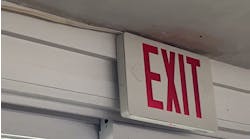When using electrical equipment in classified areas, such as lighting fixtures in Class I, Div. 2 locations, it’s an NEC requirement that the surface temperature of the fixture doesn’t exceed 80% of the autoignition temperature (AIT) of the gas or vapor involved, or shall be marked with a temperature code (T-Code) [501.130(B)]. These T-Codes can be found in Table 500.8(C).
Occasionally, questions arise such as: 1) What are these temperatures based on? 2) How conservative is the table (i.e., how much of a safety factor is included in the Table)?
For example, if a fixture is rated T3 (maximum surface temperature of 200°C allowed), where the gas or vapor involved has an AIT of 185°C present under abnormal conditions, would there actually be enough heat from the fixture surface to create a fire?
Strictly following the Code in this case, we would need to specify a fixture with at least a T3A rating (180°C). However, there’s actually quite a bit of a safety factor built into the Table. The amount of safety factor varies depending on many variable conditions. But in API RP 2216, “Ignition Risk of Hydrocarbon Liquids and Vapors by Hot Surfaces in the Open Air,” Section 5.2, Conclusion, it states: “The identification of a heated surface as the cause of ignition can often lead to an incorrect analysis of the real source of ignition. In general, ignition of hydrocarbons by a hot surface should not be assumed unless the surface temperature is approximately 360°F (182°C) above the accepted minimum ignition temperature of the hydrocarbon involved. Test data and field experience both indicate that the ignition of flammable hydrocarbon vapors by hot surfaces in the open air requires temperatures considerably above the reported minimum AITs of the hydrocarbons involved… .”
While we must follow the NEC and the label included with the fixture, it’s nice to know that if the fixture were to operate improperly and overheat a little, it probably wouldn’t result in a catastrophic explosion or fire.
© 2014 Fluor Corporation. All Rights Reserved.


